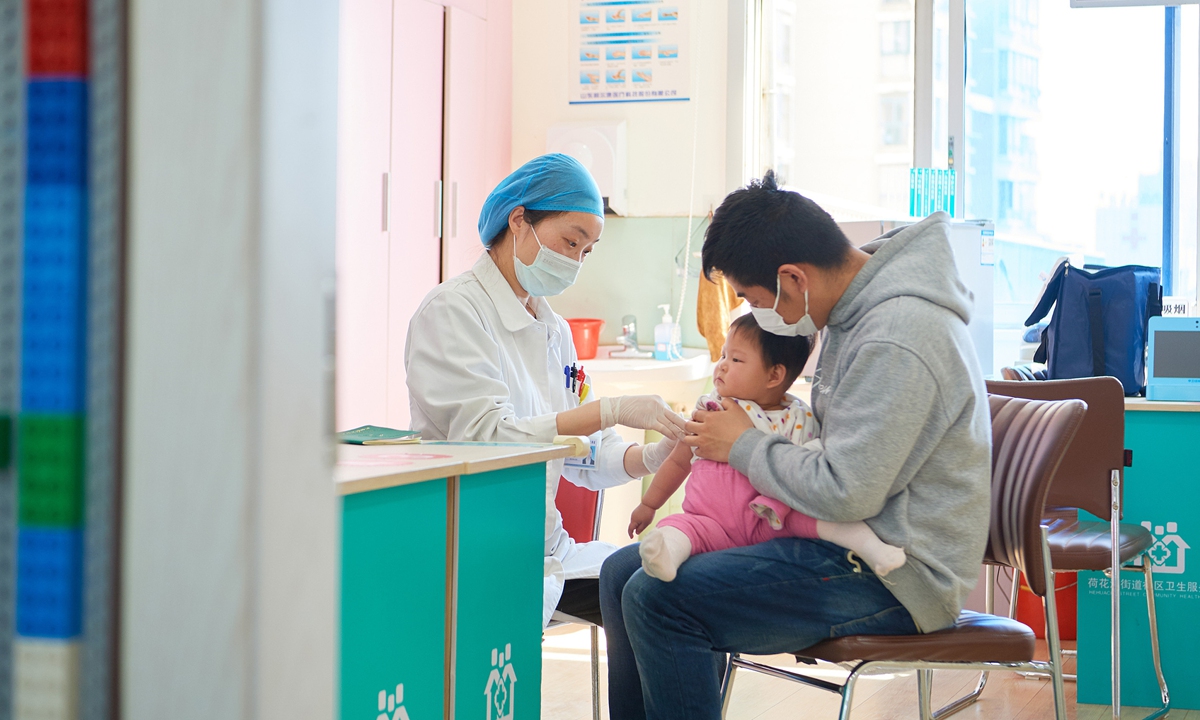China has enough output capacity of influenza vaccines, but low vaccination rate discourages producers: analyst
By Chi Jingyi Source: Global Times Published: 2020/9/17 18:33:28

A doctor injects a vaccine to a young child. Photo:VCG
Following information circulating on the internet that influenza vaccines are had to acquire, analysts and hospitals said the opposite is true and China has enough influenza vaccines.
"There have been five times as many calls this year asking about flu vaccines, but we have enough stock and supply, especially for people over three. For influenza vaccines for those under two, an appointment is required in October," a doctor in a hospital in Beijing told the Global Times on Thursday. The person requested to remain anonymous.
It is the same situation in Suzhou Xiangcheng People's Hospital, East China's Jiangsu Province. Hospital staff told reporters that they had received only three cases of flu shots in an hour, media reported.
According to the Chinese Center for Disease Control and Prevention of Guizhou in Southwest China, influenza vaccines are not available in community hospitals in the province, and now flu shots can be vaccinated in provincial-level hospitals.
Tao Lina, a Shanghai-based vaccine expert, told the Global Times on Thursday that the production cycle for influenza vaccines is about two months.
"There are two major types of influenza vaccines - inactivated vaccine and live attenuated vaccine. At present, the influenza vaccines supplied by domestic vaccine manufacturers are inactivated vaccines, generally administered by intramuscular injection," said Tao.
Changchun BCHT Biotechnology Co's live attenuated influenza virus (LAIV) vaccine has received marketing approval in February by market regulator, and the vaccine is now part of the WHO strategic action plan for pandemic influenza.
Compared with the traditional inactivated vaccine, the LAIV vaccine is delivered by nasal spray, which is easy to use for mass immunization.
"One chicken embryo can produce 15 doses of vaccine using the LAIV vaccine technology, compared with one dose traditionally, which greatly improves the production efficiency," said Tao.
In 2019, 30.78 million doses of influenza vaccines were issued, up 91 percent from 2018 on a yearly basis, while the penetration rate was only 2.2 percent, compared with 50 percent in the US, official data showed.
"China's annual vaccination rate was only around 2 percent, and the annual flu vaccine rejection rate is around 20 percent. Influenza vaccines are valid for one year after production," Tao introduced.
Tao noted that the current shortage of supply is not due to production capacity, but the low vaccination rate and high rejection rate have deterred suppliers to produce.
Analyst said that the vaccination rate this year could hit a record high of 4 percent, as everyone is suggested to take an influenza vaccine under the impact of COVID-19.
Wu Guizhen, chief biosafety expert at the Chinese Center for Disease Control and Prevention, said on Monday that early symptoms of the coronavirus are similar to those of influenza.
"We hope people can get flu shots and prevent clinical difficulties in identification of influenza and coronavirus infection. The influenza vaccine will not conflict with the COVID-19 vaccine. A flu vaccine won't help prevent COVID-19, but people can stay healthy by avoiding flu," Wu noted.
Posted in: INDUSTRIES,COMPANIES